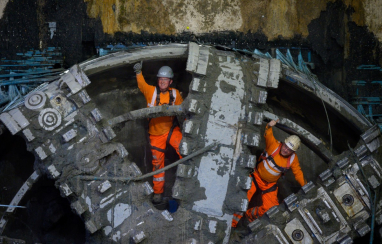
HS2 makes tunnelling breakthrough
HS2 has celebrated the breakthrough of a tunnelling machine into its underground Old Oak Common station – marking a key milestone in plans to eventually carry the high-speed line into central London.
The tunnel boring machine (TBM) named Lydia finished its near-kilometre long journey into the station box in a move that completes the construction of the Atlas Road Logistics Tunnel.
The 853m long tunnel, which runs from the Atlas Road logistics hub, is being built to service the programme to construct the line eastwards towards Euston.
It will eventually allow materials required for the Euston Tunnel to be transported to the site without clogging up local roads or disrupting work going on elsewhere at Old Oak Common station.
HS2’s London tunnels contractor, Skanska Costain STRABAG joint venture (SCS JV) constructed the logistics tunnel using a TBM made from components repurposed from a machine previously used to construct London’s Elizabeth Line.
The TBM is named Lydia, a name selected by the local community, after Lydia Gandaa – a former teacher at Old Oak Common Primary School.
The TBM broke through into the eastern end of the Old Oak Common underground station box, which is currently under construction by a separate joint venture – Balfour Beatty Vinci SYSTRA (BBVS JV).
Later this year, SCS JV will lower two additional TBMs into the box and assemble them ready to bring the HS2 line into Euston.
Once they are in place BBVS JV will seal the box and continue to construct HS2’s super-hub station.
Malcolm Codling, project client director for HS2, said: “The completion of the Atlas Road Logistics Tunnel takes us closer along our journey to bring HS2 into central London at Euston.
“The logistics tunnel is a key part of our plans to enable us to construct the Euston Tunnel and will reduce the construction impact on the local community.”
Over the past nine months, TBM Lydia has removed 62,000 tonnes of London Clay, all of which is sent by rail for beneficial reuse across the UK and has installed 535 concrete rings.
The segments for the tunnel rings were manufactured by Pacadar UK in Kent.
A team of 100 has been working around the clock to complete the tunnel, working in shifts to operate the TBM and the above ground operations.
The experienced SCS JV team have also used their expertise to develop more team members at the early stages of their careers, including apprentices and graduates for whom this was their first time constructing a bored tunnel.
The logistics tunnel will be used to deliver materials to the two Euston Tunnel TBMs, including over 56,000 concrete tunnel segments manufactured by STRABAG in Hartlepool, and take away the London Clay excavated.
Bringing in materials by road and removing the excavated spoil for the Euston Tunnel would have been logistically challenging and would have had significant impact local roads and on the work to construct the station.
Following the government’s Network North announcement in October, alternative funding arrangements for the delivery of Euston station are being considered.
However, work is continuing with the preparations and design of the railway between Old Oak Common and Euston.